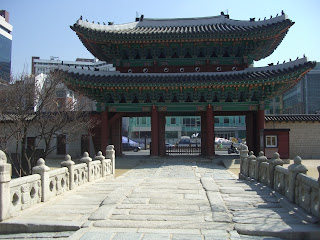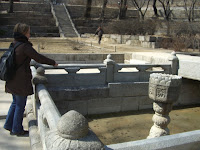Yesterday Stephanie and me set out for a big sightseeing palace tour. As you can imagine there are quite some palaces here in Seoul ;) Now there are three less on the list which I haven't visited yet.
Changgyeong Palace (Palace numero uno)
First we wanted to go to Changdeok Palace but since the English tour there was going to start in the afternoon and it was still before noon we decided to visit Changgyeong Palace first (don't they all sound the same to you? ;) The two palaces are directly next to each other so it was no problem to switch our plan.
 |
| Second Gate of Changgyeong Palace |
When we arrived the English tour had started there already. We decided to look around on our own, but soon a woman approached us and asked whether we still wanted to join the English tour. There were only three participants (one American and two Koreans) so far and they had only talked about history, so we didn't miss a lot of stuff ;)
So far Changgyeong Palace is one of my favorites, it is so much less crowded; therefore it is quite easy to get pictures without other people on it. The atmosphere is a lot more solemn and the paint on the palace buildings already faded a lot, which gives it an older and more antique look. It's also quite spacious with lots of trees and plants so it will be very nice to visit again in spring.
 |
| First Gate with a busy street outside |
 |
| The forbidden bridge |
Changgyeong Palace was first built in the 15th century and like most (all?) palaces in Seoul it was destroyed during the Japanese invasion between 1592 and 1598. It was rebuilt but parts of it burned down several times during the centuries. Some buildings just burned but others were burned down during a revolt and the Yi Gwal Rebellion. In the beginning of the 20th century some palace buildings were demolished by the Japanese to make place for a zoo and botanical garden. Nowadays, there is of course no zoo anymore. Apparently merely a fifth of the original buildings can be found on the palace grounds now.
 |
| The main throne hall |
What is special about the palace is actually the direction which the main gate and throne hall face. Usually they face south according to Fengshui but in this palace they face east. The main reasons for this seem to be topography and that it originally wasn't built as a a seat of government but as a residence, in the beginning for King Jeongjo's mother.
 |
| Faded colors... |
|
|
I really loved the wide courtyard which had some random trees in it, making the whole structure appear very spacious and natural. You wouldn't have imagined being somewhere in the middle of Seoul but rather on a secluded mountain or forest.
 |
| Main courtyard |
The way the roofs are arched is actually one of the main distinguishing points between Korean, Japanese and Chinese traditional architecture. Don't ask me about the exact up-and-downs though please ;)
 |
| Korean traditional roof-structure |
 |
| Sightseeing professionals by now :) |
Behind Stephanie and me you can see a huge slab of rock which is apparently the only one on the palace grounds. After climbing the stairs you had a nice view over the palace grounds and you can see Seoul N Tower in the very background.
 |
| On (somewhat) higher grounds |
Looking at this picture (and when you are actually there, the view) you still can't feel that you are really in the middle of Seoul, but if you look at the left-side of the picture you can actually see some skyscrapers behind the tree branch.
You can also find a replica of a sundial there which as our tourguide explained to us is special because of its concave form. Since it was a very sunny day we tried reading the time and it was absolutely exact! Amazing! It even shows you the season and everything!
 |
| Our tour guide explaining the sundial |
We followed a small path through some woods to a small clearing where we found this kind of statue:
 |
| Big turtle |
Guess three times for what purpose these statues were erected back then...
Done?
well...it marks the burial place of the king's placenta. So when a new prince was born, his placenta was washed one-hundred times (with water and the last time with wine) and afterwards it was buried at an auspicious place and this kind of statue was placed on top of it.
Going further through the woods we arrived at a large pond, called Chundangji. Originally at the location of Chundangji were rice paddies used by the king (to give a good example to the public). Here our tour guide said goodbye (after more than an hour) and we were left to wander around the palace grounds alone.
 |
| Chundangji |
 |
| Mandarin duck on Chundangji |
Behind the pond which was inhabited by many cute Mandarin ducks is the Great Greenhouse, Korea's first modern conservatory. The greenhouse building does look quite ugly because it doesn't fit with the rest of the palace buildings (sorry, no picture) but it was very warm and cozy inside, so we stayed for some time.
Wandering around by ourselves we had a look at the main courtyard again and found this "wishing" stone in one corner.
 |
| Wishing stone |
Noone explained it to us, but I guess it's quite self-explanatory. You throw coins from a distance (because of the water) and when it stays on the top it is good and you have a wish or something. We both tried but no luck...next time I will bring my piggy bank...you can't buy anything with 10 krw coins anyways (worth around 0.006 euro)...so I might well enough try to get lucky :)
Changdeok Palace (palace numero dos)
We crossed over to Changdeok Palace through a small backgate, which connects both palaces directly to each other. Since we were both a little bit tired and cold (because of the wind) we went into a small café in the tourist shop and warmed up before the English guided tour was supposed to start.
This palace is a lot bigger and better restored than the one we visited before and therefore more tourists go there as well. Our tour group was quite big but it was ok because it was getting a little bit exhausting to listen attentionately and we had more time to take pictures ;)
 |
| Main gate |
 |
| Our tour guide in front of the library building |
When our tour guide explained that the books and scrolls of the library building were abducted by the French and not yet returned (although there have apparently been meetings by the heads of states of France and Korea more or less recently which had the outcome that the artifacts will be returned at one point in the future), the two French in the tour group diligently apologized on the behalf of the French nation ;)
 |
| Two-story hall |
 |
| Close-up |
Changdeok Palace was also built during the 15th century, destroyed by the Japanese and several other occurences (mainly fires) over the times and of course rebuilt several times as well. It was even invaded by army rebels and angry crowds in 1882.
Its purpose for a long time was the residence of the king. It includes a huge garden where even the queen had to ask permission from the king before she was allowed to go there. We didn't go to the garden though because you can only enter with an extra tour (which takes around two hours) and we decided it would be a lot more beautiful in spring.
The palace grounds are huge and there are many different buildings, so I often felt very disoriented ;)
Intermission: Tapgol Park
We felt quite hungry after all the sightseeing and tour-taking, so we walked through the area until we found a nice restaurant. Afterwards we wanted to go to palace number three but passed, coincidentally, Tapgol Park on the way there and of course had a look around.
In Tapgol Park you can find a really beautiful 10-tier stone pagoda. Unfortunately, I don't know why, the Koreans built a really ugly glass-box around it, so I couldn't take any pictures. Tapgol Park is the first Western-style park and has high historical significance. It was there where the Korean Declaration of Independence was signed and (uhm) declared. This was one of the marking stones in the protest against Japanese rule. You can find statues of Son Byeong-hui (an important figure in the Independence Declaration) and other resistance rebels there.
 |
| Son Byeong-hui |
 |
| Random Rebel |
Because of its historical and political significance you can find small trees adorned with Korean flags.
 |
| A very Korean tree ;) |
Unhyeongung Palace (palace numero tres)
Thanks to Stephanie's great sense of orientation we finally found the last palace which we wanted to see that day: Unhyeongung Palace. Compared to the other palaces this one is really small and quite modest and there are no guided tours available. This made it actually quite charming and because we came only 30 minutes before it closed there weren't really any other people around.
 |
| Unhyeongung Palace |
The palace's name translates very poetically to Cloud Hanging Over the Valley Palace. It was build in the 19th century, so it's far more recent than the other ones we visited that day (which doesn't make it less beautiful of course!).
 |
| Being happy in Unhyeongung Palace |
The doors in the palaces are often very small, because back then Koreans were around 1,50 to 1,60m tall. I found one door which was even too small for me :)
 |
| Really small door |
All in all, the day was really great so I had a dance of joy at the end of it :)
 |
| Dance of Joy |



































Keine Kommentare:
Kommentar veröffentlichen